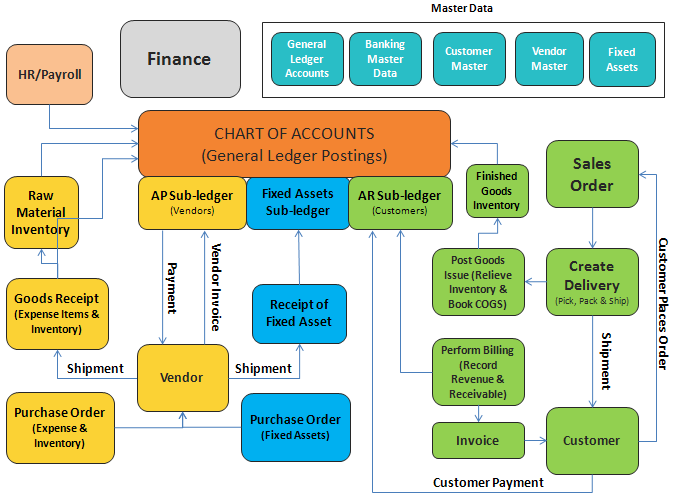
- •Introduction to sap
- •Sap Module Introduction
- •Sap business bydesign
- •Sap business one
- •About sap supplier relationship management software
- •About sap xapps
- •Sap Financial Accounting (sap fi)
- •Financial Accounting includes the following sub-modules:
- •Business process associated with the sap fi module:
- •Sap Financial Supply Chain Management (sap fscm)
- •Business process associated with the sap co module:
- •Subcomponents of the sap Controlling (sap co) Module:
- •Sap Sales and Distribution (sap sd)
- •Order to Cash business process associated with the sap sd module:
- •Subcomponents of the sap Sales and Distribution (sap sd) Module:
- •Sap Logistics Execution (sap le)
- •Sap Production Planning (sap pp)
- •Diagram of the typical Plan to Produce business process associated with the sap pp module:
- •Sap Production Planning (sap pp) is compromised of the following modules:
- •Sap Quality Management (sap qm)
- •The Quality Management (qm) process can integrate with the following sap modules:
- •Sap Plant Maintenance (sap pm)
- •Both Corrective and Preventative maintenance processes exist in the Plant Maintenance module.
- •Subcomponents of the sap Plant Maintenance (sap pm) Module:
- •Sap Project System (sap ps)
- •Common processes in Project System include:
- •Sap Human Resources (sap hr)
- •Sap Human Resources (hr) Components or Sub-Components:
- •Typical Hire to Retire business process associated with the sap hr module:
About sap supplier relationship management software
Many businesses want to strengthen their supplier relationships and make procurement a more strategic process. The SAP Supplier Relationship Management (SAP SRM) application automates, simplifies and accelerates procure-to-pay processes for goods and services. With SAP SRM, you can reduce procurement costs, build collaborative supplier relationships, better manage supply bases, and get faster time to market.
About sap xapps
SAP xApps, or Composite Applications, are based on the SAP ESOA, meaning they use SAP enterprise SOA services and run on an SAP NetWeaver application server. SAP xApps include small-footprint software products from SAP, SAP partners and customers. Most xApps are targeted at specific industries or verticals.
Sap Financial Accounting (sap fi)
The Financial Accounting (SAP FI) module in SAP is designed to capture organizations business transactions in a manner that will satisfy external reporting requirements. Local legal considerations are pre-delivered with the system and the ability to manage and report on multiple companies in multiple countries with multiple currencies is part of standard functionality. Integration with Sales and Distribution, Purchasing and Materials Management allows for the ability to select any financial transaction and "Drill Down" to the originating transaction whether it is a purchase Order, Sales Order or material movement.
Financial Accounting includes the following sub-modules:
General Ledger (FI-GL)
Accounts Payable (FI-AP)
Accounts Receivable (FI-AR)
Bank Accounting (FI-BL)
Asset Accounting (FI-AA)
Funds Management (FI-FM)
Travel Management (FI-TV)
Special Purpose Ledger (FI-SL) (I am not sure this is really considered a module anymore)
The flexibility of the Finance modules organizational structure gives the module the ability to handle any economic situation. Whether a smaller organization with a single legal entity or a large organization with numerous companies, consolidations and varying legal requirements, the FI module can support and automate most financial postings and reporting. Below is a listing of the main organizational elements in the Finance module:
Company Code - Represents a legal reporting entity. There can be numerous company codes within an organization. Each has its own balanced books and reports itself as a single economic entity.
Credit Control Area - If credit management is being used, this sets the general parameters for how credit is managed. The credit control area can control credit for a single company code representing a decentralized credit management approach or multiple company codes representing a more centralized credit management approach.
Chart of Accounts - The system supports single or multiple charts of accounts providing the ability to record transactions and report financially in many different regulatory environments. A chart of accounts can support multiple Company Codes if necessary.
Business process associated with the sap fi module:

The Finance Module is designed to record financial transactions in a manner consistent with external reporting. External reporting must be in compliance with a country's accounting principles and is required for public entities, regulatory agencies and information required by banks and other lenders. The module also handles legal consolidations, receivables, payables, fixed assets as well as banking functions if required.
This is brief review of the components and processes associated with the SAP FI module. For a more in-depth understanding of the Financial Accounting module, please review our available SAP Financial Accounting training.
Please Note: The Learn SAP pages on this site are intended to be brief summaries for SAP customers who are encountering SAP for the first time. For more advanced knowledge, please review the articles in our SAP Library, and our SAP Trainingofferings for both Super Users and Project Teams.
